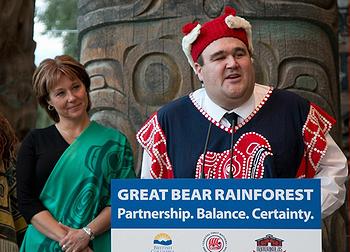
VICTORIA, British Columbia, Canada, February 3, 2016 (ENS) – First Nations, environmental groups and coastal forest industry representatives joined the premier of British Columbia Monday to celebrate achieving ecosystem-based management in the Great Bear Rainforest, inhabited by rare white “spirit bears.”
Twenty years in the making, the agreement defines ecosystem-based management in this area of British Columbia’s central and northern coast as “concurrent achievement of high levels of ecological integrity and high levels of human well-being.”

Premier Christy Clark said, “The Great Bear Rainforest is a global treasure, and all British Columbians have a stake in protecting it. Under this landmark agreement, more old- and second-growth forest will be protected, while still ensuring opportunities for economic development and jobs for local First Nations.”
Under the new Great Bear Rainforest land-use order, ecological integrity is achieved through increasing the amount of protected old-growth forest to 70 percent from 50 percent.
As well, eight new special forest management areas covering almost 295,000 hectares will be off-limits to logging. Six may receive additional protection based on ongoing discussions with First Nations.
With the new measures, 85 percent of the forest will be protected and 15 percent will be available for logging, supporting local jobs.
Under this agreement, the commercial grizzly bear hunt will cease in Coastal First Nations’ traditional territories.

White Kermode bears, often called “spirit bears,” live in the Great Bear Rainforest. White or cream-colored coats occur in about one-tenth of this subspecies of the American black bear, due to a double recessive gene unique to the subspecies, Ursus americanus kermodei.
Fewer than 400 Kermode bears are estimated to exist in the coastal area that stretches from southeast Alaska south to the northern tip of Vancouver Island.
The Great Bear Rainforest was established through land-use decisions announced in 2006. This globally unique area covers 6.4 million hectares on British Columbia’s north and central coast, and is home to 26 distinct First Nations.
The province has signed reconciliation protocols with the Coastal First Nations and Nanwakolas Council. Through these government-to-government relationships, separate human well-being agreements have been reached to address issues of special concern to each group of First Nations.
Dallas Smith, president, Nanwakolas Tribal Council, said, “Over the last 10 years we have worked with stakeholders and the province to complete a common land and marine use vision for both the Great Bear Rainforest and the Great Bear Sea. We are happy that we have also developed tools like Strategic Engagement Agreements and Reconciliation Protocols to help us continue down a path towards true respect and reconciliation.”
In addition, the province has committed to amending atmospheric benefit-sharing agreements with Nanwakolas and Coastal First Nations, increasing the forest carbon credits they can use to support implementation of ecosystem-based management and community development projects.

On behalf of the Rainforest Solutions Project, which includes Greenpeace, ForestEthics Solutions and Sierra Club BC, forest and climate campaigner Jens Wieting said, “The new framework for the Great Bear Rainforest is now a reality on the ground. It allows for long-term prosperity, including forestry with certainty, and ensures that the magnificent forest home for spirit bears, salmon and wolves will be safe for future generations.”
“The Great Bear Rainforest is now a landscape of hope. It is a landscape where economic activity will again begin to align with nature’s limits,” said Wieting.
Because of the uniqueness of the Great Bear Rainforest and the innovative elements in the new and amended agreements, the British Columbia government intends to introduce supporting legislation this spring.
Forests, Lands and Natural Resource Operations Minister Steve Thomson said, “I am proud of what all the partners in this long planning process have been able to accomplish. First Nations have new forest tenures, and an increased role in compliance and monitoring. One-third of the Great Bear Rainforest is fully protected, and the amount of old-growth forest protected is increasing to 70 percent.”
Thomson said, “We are able to offer stability, economic opportunity and certainty for local communities and local forest companies along with their employees, investors and customers.”
The land-use order addresses First Nations’ cultural heritage resources, freshwater ecosystems and wildlife habitat. The amount of habitat protected for the marbled murrelet, northern goshawk, grizzly bear, mountain goat and tailed frog will increase as new reserves required by the order are developed.
Chief Marilyn Slett, president, Coastal First Nations, said, “The Great Bear Rainforest – a global ecological treasure – has been home to our communities on the Central and North Coast and Haida Gwaii for more than 10,000 years.
“Ecosystem-based management is the modern term which describes what we have always believed and practiced. If we use our traditional knowledge to take care of our lands, waters and resources they will take care of us,” said Chief Slett. “Our vision for the future is one where ecosystems and potential developments in the Great Bear Rainforest are in balance.”
Copyright Environment News Service (ENS) 2016. All rights reserved.
© 2016, Environment News Service. All rights reserved. Content may be quoted only with proper attribution and a direct link to the original article. Full reproduction is prohibited.
